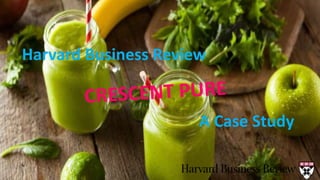Crescent Pure
- 1. Harvard Business Review A Case Study
- 2. âĒ Peter Hooper founded Crescent pure in 2008. âĒ It was all-natural beverage lightly infused with organic juices, herbal stimulants, and electrolytes. âĒ The drink retailed for $3.75 for an 8- ounce can.
- 3. INGREDIENTS âĒ Clear colored liquid. âĒ Tastes like a fruit. âĒ Flavor: Lime juice, leamon juice, raw cane sugar, green tea. âĒ Certified organic âĒ Herbal supplement: caffeine, ginseng.
- 4. ACQUISITION âĒ Portland Drake Beverages(PDB) was a organic juice manufacturer. âĒ With consumer demand PDBâs revenues had increased to $120.5 million by 2012. âĒ After months of research and negotiations, PDB acquired Crescent.
- 5. KEY PLAYERS of PDB âĒ CEO: Michael Booth âĒ Vice President of Marketing: Sarah Ryan âĒ Founder of Crescent Pure: Peter Hooper âĒ Director of Market research: Matt Levor
- 6. SITUATIONAL ANALYSIS âĒ After acquiring Crescent pure in 2013,PDB planned to soft launch in three states. âĒ Advertising campaign budget allotted was $750,000. âĒ Ryan has to evaluate positioning opportunities and recommend positioning strategy in 6 weeks.
- 7. OBJECTIVES âĒ Industry specifics of positioning options. âĒ Potential Benefits and drawbacks of each option. âĒ Final recommendation.
- 9. Positionin g Options 1. Energy Drinks 2. Sports Drinks 3. Organic Drinks
- 11. Market Size & Consumer Data Energy Drinks âĒ Growth: 40% increased between 2010-2012. âĒ Market: Projected to $8.5 billion in 2013 and $13.5 billion by 2018. âĒ Consumers: Men of 18-34 years old. âĒ Volume: People with income below $25,000 per year. Sports Drinks âĒ Growth: Only 9% increase between 2007-2012. âĒ Market: Expected to grow to $9.58 billion by 2017. âĒ Consumers: Half of the men and one third of women. âĒ Refreshing: 40% men and 27% female.
- 12. Competition Energy Drinks âĒ Fright: 34% âĒ Razor: 27% âĒ Torque: 16% âĒ Stellar: 8% Sports Drinks âĒ Gleam: 73% âĒ Drip: 21% âĒ Other 20 producers: 6%
- 13. Energy Drinks âĒ Rising sales of energy drinks with lower levels of caffeine and purer ingredients for healthier food and beverage choices. Sports Drinks âĒ Growth in new diet and low-sugar sports drinks. âĒ Expected market size increase from $1.4 billion to $2.97 billion by 2017. Opportunity
- 14. Energy Drinks âĒ New stories were highlighting the drinks alleged health risks. âĒ Increase in health consciousness resulted in decreased consumption. Sports Drinks âĒ Concern regarding rising childhood obesity rates resulted in government mandated guidelines to remove high calorie sugary drinks and snacks, including sports drinks from school vending machines in 2014. Threats
- 15. Percentage of respondents indicated a word WORD ENERY DRINKS SPORTS DRINKS Refreshing 12% 34% Healthy 6% 16% Affordable 5% 11% Functional 22% 28% Too sweet 9% 8% Suitable for Teens 7% 22% Fun 9% 11% Natural 4% 6% Hydrating 11% 49% None of these 52% 27%
- 16. Demographics AGE RANGES % 18-24 44 25-34 36 35-44 15 45-54 3 55+ 2 Male 59 Female 41 College degree 62 Household income(median) $42500
- 17. Percentage of respondents who described crescent DESCRIPTOR % Refreshing 35 Healthy 22 Affordable 29 Functional 47 Too sweet 9 Suitable for Teens 8 Fun 19 Natural 38 Hydrating 29
- 18. Perpetual Map: Hydration vs. Energy Interpretation âĒ Energy drinks have high energy and low hydration value. âĒ Sports drinks have low energy and high hydration value.
- 19. Perpetual Map: Nutrition vs. Taste Interpretation âĒ Energy drinks have high Taste with low Nutrition. âĒ Sports drinks have low taste with high Nutrition.
- 21. Retailer: âĒ Quick depletion of inventory âĒ Sales before replenishing inventory despite of increasing price by 25%. âĒ Popular among ages 18-30. âĒ More number of women customers. Focus group: âĒ Customer satisfaction in a) Taste b) Price c) Energy
- 22. BREAK EVEN ANALYSIS CATEGORY AMOUNT Total Budget $750,000 Variable cost per can $1.02 Cans per a case 24 Selling price of can $1.24 Profit per can $0.22 Total cans to be sold per month to attain break even 11838 Manufacturing capacity per month 12000
- 26. DISCLAIMER Created by Dongari Gowtham, NIFFT Ranchi, during a marketing internship by Prof. Sameer Mathur, IIM Lucknow.


























